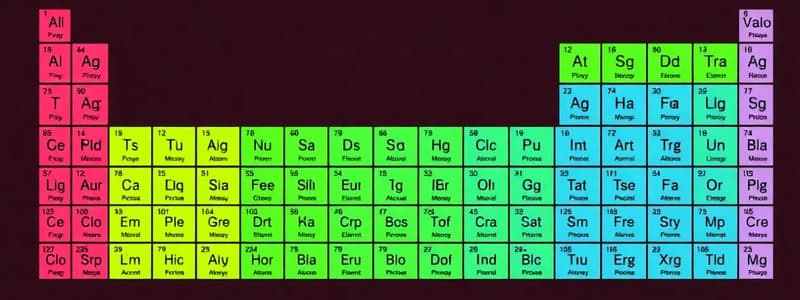Podcast
Questions and Answers
What principle does the modern periodic table primarily follow for organizing elements?
What principle does the modern periodic table primarily follow for organizing elements?
- Increasing atomic number (correct)
- Decreasing atomic mass
- Decreasing atomic number
- Increasing atomic mass
Which scientist is recognized for creating the first periodic table?
Which scientist is recognized for creating the first periodic table?
- Dmitri Mendeleev (correct)
- Lothar Meyer
- John Dalton
- Albert Einstein
What is the maximum number of electrons that can fill the second energy level of an atom?
What is the maximum number of electrons that can fill the second energy level of an atom?
- 8 (correct)
- 2
- 16
- 4
What did Mendeleev do when he encountered gaps in his periodic table?
What did Mendeleev do when he encountered gaps in his periodic table?
Elements in the same period of the periodic table have:
Elements in the same period of the periodic table have:
How did Mendeleev arrange elements in his periodic table?
How did Mendeleev arrange elements in his periodic table?
Which of the following statements is true about early models of the periodic table?
Which of the following statements is true about early models of the periodic table?
What did the periodic law established by Mendeleev state about elements?
What did the periodic law established by Mendeleev state about elements?
Flashcards
Periodic Table
Periodic Table
A chart that organizes elements by increasing atomic number and groups them based on similar chemical properties.
Atomic Number
Atomic Number
The number of protons in the nucleus of an atom. It determines the element's identity.
Atomic Mass
Atomic Mass
The average mass of an atom of an element.
Periods (Periodic Table)
Periods (Periodic Table)
Signup and view all the flashcards
Groups (Periodic Table)
Groups (Periodic Table)
Signup and view all the flashcards
Periodic Law
Periodic Law
Signup and view all the flashcards
Bohr Model
Bohr Model
Signup and view all the flashcards
Electron Configuration
Electron Configuration
Signup and view all the flashcards
Study Notes
The Periodic Table
- The periodic table is a visual way to organize all elements.
- Dmitri Mendeleev is credited with creating the first periodic table in 1869.
- Lothar Meyer also developed a similar table around the same time.
- Elements are organized by increasing atomic mass
- Elements with similar properties are grouped together.
- The rows are called periods, and the columns are called groups or families.
- Elements in the same period share the same number of electron shells.
- Mendeleev observed regular patterns in the properties of elements.
History of the Periodic Table
- Early models of the periodic table were based on atomic weight, not atomic number.
- Early tables were incomplete because some elements were placed to fill gaps that appeared periodically when ordered by atomic weight.
- Dmitri Mendeleev's periodic table was a significant improvement in organization, putting elements with similar properties in the same column.
- He arranged elements by increasing atomic weight, focusing on properties of the elements and their compounds.
- Mendeleev left gaps in the table for elements that had not yet been discovered.
Atomic Structure
- The atomic number tells the number of electrons needed to be drawn.
- Electrons start in the lowest energy shell (this shell is closest to the nucleus)
- The maximum number of electrons in each shell are: two in the first shell, eight in the second shell, eight in the third shell.
Studying That Suits You
Use AI to generate personalized quizzes and flashcards to suit your learning preferences.




